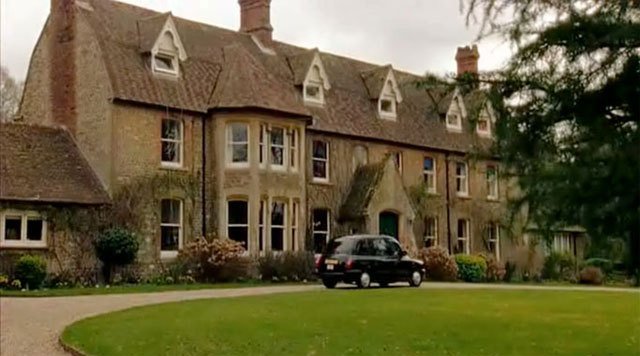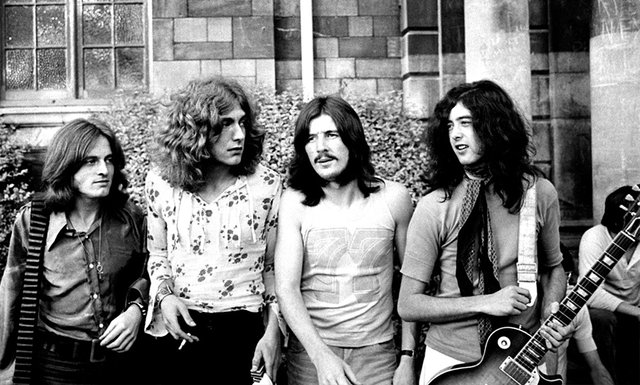Led Zeppelin: Part 7, Led Zeppelin IV
Many fans and critics thought that Led Zeppelin had stumbled with their third album. Stung by the criticism, the group produced something extraordinary.
:format(jpeg):mode_rgb():quality(90)/discogs-images/R-4196673-1360236880-1140.jpeg.jpg)
Image source
In Led Zeppelin: Part 5, Led Zeppelin III, we learnt how an exhausted band had put together a more acoustic, folky-sounding record. Although not well received, it became the stepping-stone to their next album.
Back to the country
After the release of Led Zeppelin III in October 1970, the band departed from their usual practice of heading off on another exhausting tour, instead deciding to concentrate on recording another album. Following the pattern of putting together their last album, they returned to Bron-Yr-Aur, the rural cottage in Wales where so many of the songs on Led Zeppelin III were penned.
In December 1970, with some new material in hand, they began recording at Island Records' Basing Street Studios in London. Jethro Tull was recording Aqualung there at the same time. In January they once again—as with Led Zeppelin III—relocated to Headley Grange and used the Rolling Stones Mobile Studio for recording. The studio came with engineer Andy Johns who had just finished working on the Stones' Sticky Fingers.

Headley Grange, Hampshire, England. Image source
Headley Grange
The band enjoyed working in the relaxing environment of Headley Grange. “We needed the sort of facilities where we could have a cup of tea and wander around the garden and go in and do what we had to do”, recalled Jimmy Page. Jones, however, called it “horrible.”

John Paul Jones, Robert Plant, John Bonham and Jimmy Page, Headley Grange, 1971. Image source
Without a bar or other distracting facilities, the lads spent most of their time working and jamming, and were able to capture spontaneous performances immediately.
One of those was recording the massive When the Levee Breaks drum sound. Bonham performed this in the Headley Grange stairwell, with its natural echo producing great reverb.
Fighting back
The band members—and Jimmy Page in particular—were very upset by the attitude of the critics toward them. It seemed that no matter what they did, the critics just snubbed them. They found the criticism to be mainly personal, against the band. Page's resentment led him not to give a press interview in over 18 months.
Page had already cut back on band information on Led Zeppelin III, but now decided to take it to a new level: the album would remain untitled and would carry no reference to the band. The music would speak for itself.
The band members were represented by four symbols which each member chose for himself. Said Page:
After all this crap that we’d had with the critics, I put it to everybody else that it’d be a good idea to put out something totally anonymous. At first I wanted just one symbol on it, but then it was decided that since it was our fourth album and there were four of us, we could each choose our own symbol.

Led Zeppelin IV “ZoSo” symbols. Image source
The symbols
Page chose the so-called “ZoSo” symbol, which he contends was not meant to be a word at all. It seems to be an ancient sign for his sun sign, Capricorn.
The second sign was chosen by John Paul Jones from Rudolph Koch’s Book of Signs, as was the third, chosen by John Bonham.
Robert Plant’s symbol is the feather of Ma’at, the Egyptian goddess of justice and fairness, and is the emblem of a writer (and presumably a song lyricist).
But there was a fifth symbol, for Fairport Convention's Sandy Denny who sang on The Battle of Evermore:

An old symbol for the Godhead. Image source
Denny was the only non-member ever to be credited as a vocalist on a Led Zeppelin album.

Sandy Denny with John Bonham, Robert Plant and Jimmy Page, 1971. Image source
Getting it done
The basic tracks were recorded at Headley Grange and overdubs were added at Island Studios in February. Page then took the completed master tapes to Sunset Sound in Los Angeles for mixing, with a plan for an April 1971 release. But the band disliked the results, and so after touring through the spring and early summer, Page remixed the whole album in July.
The release was again delayed over the choice of cover and format.
The cover features a 19th-century oil painting that Plant bought at an antique store. It was put on a partly demolished home which Plant says represents the change in balance and is a way of saying we should look after the earth.
Page came up with the typeface used on the album. He found it in a 19th-century arts and crafts magazine and had the entire alphabet created.
The album was finally released on 8 November 1971, a full nine months after recording was completed.
The album was an instant commercial success. It is Led Zeppelin's best-selling album, shipping over 37 million copies worldwide. It entered the UK chart at No. 10, hitting No. 1 a week later and staying on the charts for a massive 90 weeks. It didn't reach No. 1 in the US (the American public favouring There's a Riot Goin' On by Sly and the Family Stone), but was their largest seller in North America and their most durable seller.
The songs
Led Zeppelin IV, as the album came to be known, is the band at its best. It puts the group's musical schizophrenia on magnificent display, rocking hard, side by side with soft, mystical songs. In every way possible, it confirmed their superstar rock status.
The record opens with Black Dog, named after a mutt that hung around Headley Grange during recording. It is a complex, multi-layered song based on a riff written by Page and Jones. Lyrics by Plant. Interestingly, the guitar solos on the outro were recorded directly into the desk, without using an amplifier.
Rock and Roll, is certainly one of my favourite Led Zeppelin pieces. It has never failed to get people rocking over the decades. It came out of a jam session at Headly Grange while trying to get Four Sticks right. It became a favourite at concerts, usually on the opening encore. To me, John Bonham starts showing why he came to regarded as one of the best drummers in the world.
The Battle of Evermore, a gentle folk, mystic song, was written by Page on a borrowed mandolin—an instrument he had never played before. Page wrote the lyrics based on a book he was reading on the Scottish Independence Wars. Sandy Denny supports Page with her haunting vocals.
Then, their most famous song, Stairway to Heaven. It builds from quiet guitar picking to stormy guitar riffs and vocal fireworks. The breadth of the Led Zeppelin sound is encapsulated in this one song. The song was written at Headley Grange, mainly by Page (with all band members contributing) and Page contributing the lyrics. Page played the guitar solo on the Fender Telecaster given to him by Jeff Beck, but had to use the double-necked Gibson EDS-1275 for live performances, as can be seen in this video:
The song was played—and continues to be played—by radio stations around the world. An earlier plea by radio stations to provide a shorter, “radio-friendly” version fell on deaf ears, so it became the first long song (over 8 minutes) to be played regularly. DJs welcomed it so they could take a bathroom break.
Side Two opens with Misty Mountain Hop, is rock song Plant called “hippy-trippy”. It deals with student clashes with police around drug possession. The title comes from Tolkien's The Hobbit. It's a song Plant continued to perform on solo tours.
The only song on the album not to make the group's 1990 box set, Four Sticks has a complicated drum pattern that makes it perhaps less accessible than the other songs on the album. The title comes simply from the fact that Bonham played with four drumsticks on the track. It proved to be difficult to record and was only ever played live once. I'm a sucker for complex drum patterns so I've always enjoyed it.
Going to California is the other quiet acoustic track on the record. It is probably the group's best folk song. It was written by Page and Plant about earthquakes and trying to find the perfect woman. The music was inspired by Canadian folk-singer Joni Mitchell, to which both Plant and Page were devoted. The song was regularly performed at their concerts in the “acoustic set”.
The album closes with the heavy, blues-driven When the Levee Breaks. John Bonham outdoes himself, and the song is one of the most heavily sampled drum tracks of all time. As we know, the drum track was recorded in Headley Grange's stairwell. However, it was slowed down in mixing to give it an even heavier, booming sound. In fact, Plant's voice is the only sound that was run at natural speed. Critic Thomas Erlewine said about the song:
When the Levee Breaks, is the one song truly equal to “Stairway,” helping give IV the feeling of an epic. An apocalyptic slice of urban blues, When the Levee Breaks is as forceful and frightening as Zeppelin ever got, and its seismic rhythms and layered dynamics illustrate why none of their imitators could ever equal them.
I can't find any good footage of the band playing When the Levee Breaks, so here's the original audio:
The critics
Boy, what a turnaround from the critics! Perhaps it was Page's gambit to provide the critics with nothing but the music, but Led Zeppelin IV received overwhelming praise from the critics. The previously luke-warm Rolling Stone raved, saying, “out of eight cuts, there isn't one that steps on another's toes, that tries to do too much all at once”.
Stephen Erlewine retrospectively credited the album for “defining not only Led Zeppelin but the sound and style of '70s hard rock”, while “encompassing heavy metal, folk, pure rock & roll, and blues.”
There's no one better to quote on the subject than Robert Plant, who said, “the fourth album, that's it”.
Previous posts in this series:
Led Zeppelin: Part 1, The Making Of
Led Zeppelin: Part 2, The First Album
Led Zeppelin: Part 3, Led Zeppelin II
Led Zeppelin: Part 4, Jimmy Page
Led Zeppelin: Part 5, Led Zeppelin III
Led Zeppelin: Part 6, Robert Plant
References:
BBC: Led Zeppelin IV Review
iHeartRadio: 35 Things You Might Not Know About Led Zeppelin IV
UCR: 10 Things You Didn't Know About Led Zeppelin 'IV'
AllMusic: Led Zeppelin IV
Wikipedia: Led Zeppelin IV
feelnumb: Led Zeppelin IV “ZOSO” Symbol Meanings
Also posted on Weku, @tim-beck, 2019-03-21
You are truly thorough , loved this Post.(and the music)
This post was shared in the Curation Collective Discord community for curators, and upvoted and resteemed by the @c-squared community account after manual review.
@c-squared runs a community witness. Please consider using one of your witness votes on us here
Congratulations @tim-beck! You have completed the following achievement on the Steem blockchain and have been rewarded with new badge(s) :
You can view your badges on your Steem Board and compare to others on the Steem Ranking
If you no longer want to receive notifications, reply to this comment with the word
STOPDo not miss the last post from @steemitboard:
Vote for @Steemitboard as a witness to get one more award and increased upvotes!